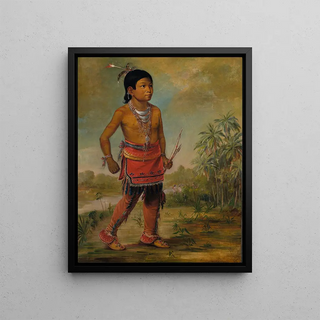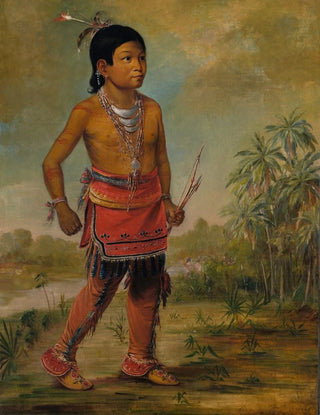Art print | Osceola Nick-a-no-chee, a boy - George Catlin


View from behind

Frame (optional)
In the rich and captivating world of 19th-century American art, George Catlin's "Osceola Nick-a-no-chee a boy" stands out for its emotional depth and commitment to representing indigenous peoples. This painting, which captures the essence of a young Seminole, invites us to delve into a world where identity and culture are highlighted with rare sensitivity. The art print of this work not only allows appreciation of Catlin's technical virtuosity but also offers a connection to a often little-known history—the story of the peoples who inhabited these lands long before European colonists arrived.
Style and uniqueness of the work
Catlin's work is characterized by a realistic and empathetic approach, where every detail is carefully considered to convey the soul of his subjects. In "Osceola Nick-a-no-chee a boy," the piercing gaze of the young Seminole seems to tell a story, that of a rich and complex cultural heritage. The vibrant colors and delicate textures of the canvas evoke not only the beauty of the Floridian landscape but also the strength and dignity of its people. Catlin, a true pioneer of ethnographic art, was able to immortalize moments of life, traditions, and rituals, thus offering a window into a changing world. This piece, both portrait and testimony, embodies Catlin's quest to preserve the memory of Native nations in the face of adversity.
The artist and his influence
George Catlin, artist and writer, is often regarded as one of the first to document the lifestyles of Native Americans with such passion. Traveling across the continent, he met and photographed tribes, capturing their essence in his paintings. His work not only influenced his contemporaries but also left an indelible mark on future generations of artists and anthropologists. By highlighting indigenous culture, Catlin contributed to a collective awareness of the need to preserve these threatened traditions. Through his art, he paved the way for a better understanding of indigenous peoples and challenged stereotypes of his

Matte finish

View from behind

Frame (optional)
In the rich and captivating world of 19th-century American art, George Catlin's "Osceola Nick-a-no-chee a boy" stands out for its emotional depth and commitment to representing indigenous peoples. This painting, which captures the essence of a young Seminole, invites us to delve into a world where identity and culture are highlighted with rare sensitivity. The art print of this work not only allows appreciation of Catlin's technical virtuosity but also offers a connection to a often little-known history—the story of the peoples who inhabited these lands long before European colonists arrived.
Style and uniqueness of the work
Catlin's work is characterized by a realistic and empathetic approach, where every detail is carefully considered to convey the soul of his subjects. In "Osceola Nick-a-no-chee a boy," the piercing gaze of the young Seminole seems to tell a story, that of a rich and complex cultural heritage. The vibrant colors and delicate textures of the canvas evoke not only the beauty of the Floridian landscape but also the strength and dignity of its people. Catlin, a true pioneer of ethnographic art, was able to immortalize moments of life, traditions, and rituals, thus offering a window into a changing world. This piece, both portrait and testimony, embodies Catlin's quest to preserve the memory of Native nations in the face of adversity.
The artist and his influence
George Catlin, artist and writer, is often regarded as one of the first to document the lifestyles of Native Americans with such passion. Traveling across the continent, he met and photographed tribes, capturing their essence in his paintings. His work not only influenced his contemporaries but also left an indelible mark on future generations of artists and anthropologists. By highlighting indigenous culture, Catlin contributed to a collective awareness of the need to preserve these threatened traditions. Through his art, he paved the way for a better understanding of indigenous peoples and challenged stereotypes of his






